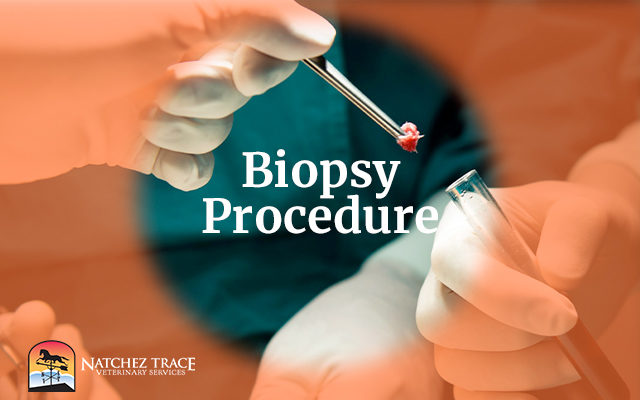Why Might You Need a Biopsy Procedure?
A biopsy procedure for dogs and cats provides important information regarding the seriousness of your pet’s condition.
A biopsy also confirms the diagnosis and the best course of treatment.
Different Biopsy Procedures for Dogs and Cats
Veterinarians use several different biopsy procedures for dogs and cats:
- Punch: This type of biopsy uses a circular blade varying in size from 1 mm to 8 mm. The blade is attached to a handle and rotates down into the tissue to extract a small cylindrical shaped sample. Topical anesthetic mitigates any pain and discomfort. Afterward, the site only needs one or two stitches, sometimes none.
- Incisional/Excisional: These are both done with a scalpel and either an entire mass or a sample of tissue is surgically removed. Sedation and/or local anesthesia may or may not be needed depending on from where the sample is taken.
- Needle: This is done with a needle and syringe utilizing the rapid sucking motion applied to the syringe to draw out fluids from under the skin and/or within tumors. The cellular aspirate is analyzed in the clinic and later sent to the lab for further testing. Sedation and/or local anesthesia may or may not be needed depending on the sample taken.
All biopsies end up at the laboratory for interpretation by veterinarians specializing in pathology.
The laboratory we currently use is Antech Diagnostics.
The laboratory specialists run tests on the sample to determine whether the tissue sample is benign or cancerous. In most situations, veterinary specialists also determine the type and grade if the sample turns out cancerous.
The results return from the lab in 5-7 days.
After we receive the results, we email a copy to you along with the doctor’s analysis and recommendations.
More Powerful Tools for Overcoming Pet Cancer Challenges
You might not be aware, but many cancer-fighting tools are easy to get and use at home.
To realize your true cancer-fighting potential:
- Learn more about pet cancer.
- Ease your dog’s discomfort naturally. PET | TAO Comfort is a blend of Eastern herbs and Western supplements to soothe your dog’s and make him/her more comfortable. Note: Comfort is not for cats.
- Boost your pet’s immune system with medicinal mushrooms. PET | TAO Complement Immune Mushroom Blend blends together the most powerful immune-boosting medicinal mushrooms on the market in a single product.
- Ease your pet’s stomach upset naturally. Many pets with cancer suffer stomach upset as well. PET | TAO Harmonize GI naturally provides all the digestive enzymes and probiotics your pet needs for optimum gut health.
- Try PET | TAO Freeze Dried Beef Spleen Treats. According to TCVM, spleen helps with digestion and assimilation. Both are challenges often faced by pets suffering from cancer. As few as 5-6 treats per day can make a huge difference in your pet’s health!
- Try a Blood-building TCVM Diet. According to TCVM theory, pets suffering from cancer also often suffer from Blood deficiency. Blood deficiency may due to chemotherapy or the cancer itself. PET | TAO Zing dog food builds Blood. You can also try home-cooking for your pet.
- Learn more about TCVM Herbal Remedies. Chinese medicine offers many amazing natural solutions for pet cancer challenges and palliative care. Some good examples are:








